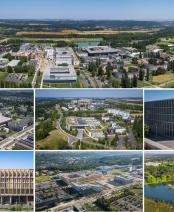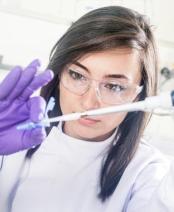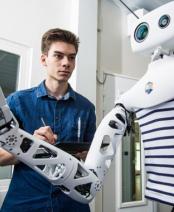Master Year 2 Large Facilities

| Year | Master Year 2 |
| Program | Large Facilities - Plasmas Lasers Accelerators Tokamaks (GI-PLATO) |
| ECTS Credits | 60 |
| Language | English |
| Orientation | Research |
| Location | Palaiseau Campus, Paris-Saclay Campus, Cadarache or Bordeaux or Geneva according to the chosen specialty |
| Course duration | 12 months, full time |
| Course start | September |
| Degree awarded | Master’s degree |
WHY ENROLL IN THIS PROGRAM?
Asset n° 1
Integrate a multidisciplinary program offering high-level teaching in fundamental and applied physics for large scale research facilities (particle accelerators, synchrotrons, free electron lasers, high power lasers, tokamaks).
Asset n°2
Participate in a 1-month gathering with students of other M2 programs around large installations with high international visibility (superconductive tokamak Tore-Supra in Cadarache, high-energy laser LMJ in Bordeaux, particle accelerators of CERN in Geneva).
Asset n°3
Have the opportunity to join either a public research institution (after a PhD) or a leading-edge research and development group in a private company.
This master program provides high level teaching in fundamental and applied physics for large-scale research facilities, such as particle accelerators for particle physics or synchrotrons and free electron lasers at short wavelengths but also high power laser physics with related laser plasma interactions and tokamaks for magnetic confinement fusion.
This multidisciplinary, cross-training program, bridging engineering and research, can fit engineering students intending to move towards research and university students open to engineering jobs. It will offer opportunities to integrate either a public research institution (after a PhD) or a leading-edge research and development group in a private company.
In order to provide the skills required to benefit from major research programs and the large associated facilities, one month of the program is organized near large installations with high international visibility, where courses, tutorials and hands-on sessions accompanied by visits are given to students gathered with students from other classes:
- the superconductive Tokamak Tore-Supra/West located at CEA/Cadarache near the future tokamak ITER with the students of the European master's degree Erasmus Mundus Fusion-EP;
- the high-energy laser LMJ (MegaJoule laser) delivering nanosecond pulses located at CEA/Bordeaux with the students of the master's degree of physics of the university of Bordeaux;
- the accelerators of the European Center of nuclear research (CERN) close to Geneva, with students coming from universities and laboratories dispersed all over Europe. This winter school is coordinated by the Joint Universities Accelerator School (JUAS).
Objectives
This Master’s program enables students to:
- understand all the problems associated with plasmas in large research infrastructures: theory, simulation, experimentation, instrumentation, control;
- use knowledge and practical skills in a major research program;
- link modeling to experimental reality, in a technological context involving complex and innovative prototypes;
- communicate in English during scientific work.
With strong skills on these different technologies added to knowledge of plasma physics, the M2 Large facilities graduates are equipped at the highest level to apply for positions as research scientists in physics, research engineers, design and construction engineers, project leaders, whether in the public sector within large research labs or in the private sector, within companies or industrial groups showing a strong research and development activity:
- French national research institutions : CEA, CNRS, ONERA;
- Industrial groups : AREVA, CANBERRA, ALSTOM, AIR-LIQUIDE, THALES, NEXANS, COMEX, EADS, ITHPP, …;
- European research centers : DESY, JET, …;
- International research organisations: CERN, ITER.
The future of graduate students is strongly correlated to their internship, which sheds light on the realities of the research field. Since 2015, internships have taken place in a large range of labs as shown below. Roughly:
- 55 % in a university/CNRS laboratory;
- 15 % in a CEA laboratory;
- 17 % outside France.
Core courses
|
Relativity, electromagnetism, plasmas |
16h 2 ECTS English |
|
Physics of tokamaks |
24h 3 ECTS English |
|
Physics of lasers and laser-driven plasmas |
24h 3 ECTS English |
|
Physics of accelerators |
24h 3 ECTS English |
|
Cross-cutting physics and technologies |
24h 3 ECTS English |
|
Numerical methods |
24h 3 ECTS English |
|
Projects and organization of large facilities |
24h 3 ECTS English |
|
Hands-on on large facilities |
40h 5 ECTS English |
Specialty: Accelerators
|
Material irradiation |
24h 3 ECTS English |
|
Detection and measure |
24h 3 ECTS English |
Specialty: Laser-plasmas
|
Ultra-intense laser-plasma interaction |
24h 3 ECTS English |
|
Dense plasmas |
24h 3 ECTS English |
Specialty: Tokamaks
|
Plasma-material interaction |
24h 3 ECTS English |
|
Detection, measure, radiation |
24h 3 ECTS English |
The students will pursue the specialty chosen in the first semester. They will participate in a student gathering (Geneva, Bordeaux or Cadarache according to the specialty) with students of other Master Year 2.
Specialty: Accelerators
|
Radiofrequencies |
24h 3 ECTS English |
|
Advanced technologies for accelerators (student gathering in Geneva) |
48h 6 ECTS English |
Specialty: Laser-plasmas
|
Laser-plasma interaction and inertial confinement fusion |
24h 3 ECTS English |
|
High energy density physics (student gathering in Bordeaux) |
48h 6 ECTS English |
Specialty: Tokamaks
|
Confinement, heating, transport |
24h 3 ECTS English |
|
Tokamaks: operation and researches (student gathering in Cadarache) |
48h 6 ECTS English |
A compulsory research training is scheduled from mid-March to the end of August (20 ECTS).
Admission requirements
Academic prerequisites
- Completion of the first year of a Master in physics at Institut Polytechnique de Paris or equivalent in France or abroad
Language prerequisites
- English
- Working knowledge of French will enhance the range of options available
How to apply
Applications can be submitted exclusively online. You will need to provide the following documents:
- Transcript
- Two academic references (added online directly by your referees)
- CV/resume
- Statement of purpose
- Certificate of English level (compulsory for non-English speakers)
You will receive an answer in your candidate space within 2 months of the closing date for the application session.
Fees and scholarships
Fees for 2023-2024 are :
- EU/EEA/Switzerland students: 243€
- Non-EU/EEA/Switzerland students: 4130€
- Engineer students enrolled in one of the five member schools of Institut Polytechnique de Paris (Ecole polytechnique, ENSTA Paris, ENSAE Paris, Télécom Paris and Télécom SudParis): 159€
- Special cases: please refer to the "Cost of studies" section of the FAQs
Find out more about scholarships
Please note that fees and scholarships may change for the following year.
Applications and admission dates
This master program provides high level teaching in fundamental and applied physics for large-scale research facilities, such as particle accelerators for particle physics or synchrotrons and free electron lasers at short wavelengths but also high power laser physics with related laser plasma interactions and tokamaks for magnetic confinement fusion.
This multidisciplinary, cross-training program, bridging engineering and research, can fit engineering students intending to move towards research and university students open to engineering jobs. It will offer opportunities to integrate either a public research institution (after a PhD) or a leading-edge research and development group in a private company.
In order to provide the skills required to benefit from major research programs and the large associated facilities, one month of the program is organized near large installations with high international visibility, where courses, tutorials and hands-on sessions accompanied by visits are given to students gathered with students from other classes:
- the superconductive Tokamak Tore-Supra/West located at CEA/Cadarache near the future tokamak ITER with the students of the European master's degree Erasmus Mundus Fusion-EP;
- the high-energy laser LMJ (MegaJoule laser) delivering nanosecond pulses located at CEA/Bordeaux with the students of the master's degree of physics of the university of Bordeaux;
- the accelerators of the European Center of nuclear research (CERN) close to Geneva, with students coming from universities and laboratories dispersed all over Europe. This winter school is coordinated by the Joint Universities Accelerator School (JUAS).
Objectives
This Master’s program enables students to:
- understand all the problems associated with plasmas in large research infrastructures: theory, simulation, experimentation, instrumentation, control;
- use knowledge and practical skills in a major research program;
- link modeling to experimental reality, in a technological context involving complex and innovative prototypes;
- communicate in English during scientific work.
With strong skills on these different technologies added to knowledge of plasma physics, the M2 Large facilities graduates are equipped at the highest level to apply for positions as research scientists in physics, research engineers, design and construction engineers, project leaders, whether in the public sector within large research labs or in the private sector, within companies or industrial groups showing a strong research and development activity:
- French national research institutions : CEA, CNRS, ONERA;
- Industrial groups : AREVA, CANBERRA, ALSTOM, AIR-LIQUIDE, THALES, NEXANS, COMEX, EADS, ITHPP, …;
- European research centers : DESY, JET, …;
- International research organisations: CERN, ITER.
The future of graduate students is strongly correlated to their internship, which sheds light on the realities of the research field. Since 2015, internships have taken place in a large range of labs as shown below. Roughly:
- 55 % in a university/CNRS laboratory;
- 15 % in a CEA laboratory;
- 17 % outside France.
Core courses
|
Relativity, electromagnetism, plasmas |
16h 2 ECTS English |
|
Physics of tokamaks |
24h 3 ECTS English |
|
Physics of lasers and laser-driven plasmas |
24h 3 ECTS English |
|
Physics of accelerators |
24h 3 ECTS English |
|
Cross-cutting physics and technologies |
24h 3 ECTS English |
|
Numerical methods |
24h 3 ECTS English |
|
Projects and organization of large facilities |
24h 3 ECTS English |
|
Hands-on on large facilities |
40h 5 ECTS English |
Specialty: Accelerators
|
Material irradiation |
24h 3 ECTS English |
|
Detection and measure |
24h 3 ECTS English |
Specialty: Laser-plasmas
|
Ultra-intense laser-plasma interaction |
24h 3 ECTS English |
|
Dense plasmas |
24h 3 ECTS English |
Specialty: Tokamaks
|
Plasma-material interaction |
24h 3 ECTS English |
|
Detection, measure, radiation |
24h 3 ECTS English |
The students will pursue the specialty chosen in the first semester. They will participate in a student gathering (Geneva, Bordeaux or Cadarache according to the specialty) with students of other Master Year 2.
Specialty: Accelerators
|
Radiofrequencies |
24h 3 ECTS English |
|
Advanced technologies for accelerators (student gathering in Geneva) |
48h 6 ECTS English |
Specialty: Laser-plasmas
|
Laser-plasma interaction and inertial confinement fusion |
24h 3 ECTS English |
|
High energy density physics (student gathering in Bordeaux) |
48h 6 ECTS English |
Specialty: Tokamaks
|
Confinement, heating, transport |
24h 3 ECTS English |
|
Tokamaks: operation and researches (student gathering in Cadarache) |
48h 6 ECTS English |
A compulsory research training is scheduled from mid-March to the end of August (20 ECTS).
Admission requirements
Academic prerequisites
- Completion of the first year of a Master in physics at Institut Polytechnique de Paris or equivalent in France or abroad
Language prerequisites
- English
- Working knowledge of French will enhance the range of options available
How to apply
Applications can be submitted exclusively online. You will need to provide the following documents:
- Transcript
- Two academic references (added online directly by your referees)
- CV/resume
- Statement of purpose
- Certificate of English level (compulsory for non-English speakers)
You will receive an answer in your candidate space within 2 months of the closing date for the application session.
Fees and scholarships
Fees for 2023-2024 are :
- EU/EEA/Switzerland students: 243€
- Non-EU/EEA/Switzerland students: 4130€
- Engineer students enrolled in one of the five member schools of Institut Polytechnique de Paris (Ecole polytechnique, ENSTA Paris, ENSAE Paris, Télécom Paris and Télécom SudParis): 159€
- Special cases: please refer to the "Cost of studies" section of the FAQs
Find out more about scholarships
Please note that fees and scholarships may change for the following year.












